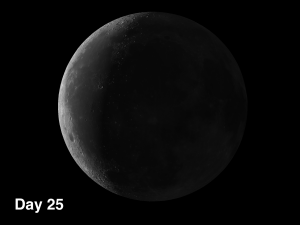 The week of April 29 – May 5 takes us from lunar Day 25 to Day 1. This week the Moon is, for all practical purposes, not viewable. On Monday morning it rises during bright morning twilight, and for the rest of the week it is too close to the Sun to view.
The week of April 29 – May 5 takes us from lunar Day 25 to Day 1. This week the Moon is, for all practical purposes, not viewable. On Monday morning it rises during bright morning twilight, and for the rest of the week it is too close to the Sun to view.
OF ADDITIONAL INTEREST – EXTRA TERRESTRIAL LIFE:
We are not alone: There are, conservatively, 100 billion stars in the Milky Way galaxy and 100 billion galaxies in the universe. That means that there are at least ten sextillion stars (that’s a 10 followed by 21 zeroes!). Scientists tell us that there are more planets than stars and that at least a quarter of them are Earth-size planets located in the so-called “Goldilocks zone” (where conditions are not too hot, not too cold, but just right for life to form). That means that within our galaxy alone there are at least 25 billion planets with the possibility of life. The question is no longer, “Is there life beyond Earth?” but “How do we find it?” We are close to developing telescopes that are powerful enough to answer that question, such as the James Webb telescope to be launched in 2021, and the European Southern Observatory’s ELT (Extremely Large Telescope) which will go into operation in 2024 with a mind-boggling 128-foot mirror! (For comparison, the Keck telescope on Mauna Kea is 32.8 feet.) Stay tuned for exciting news!
======================
It is highly recommended that you get a copy of Sky and Telescope’s Field Map of the Moon, the very finest Moon map available for use at the telescope. It is available for $10.95 at www.skyandtelescope.com and on Amazon. All features mentioned in this blog will be keyed to the grid on the Field Map and will look like this: Plato: [NW/D9]
Credits:
Courtesy of Gray Photography of Corpus Christi, Texas
Lunar photos: NASA / USGS / BMDO / LROC / ASU / DLR / LOLA / Moon Globe. Used by permission
- Rupes Cauchy: A Best Known Fault on the Moon - July 22, 2024
- Moon Crater Schickard – Crater Floor has Stripes - July 15, 2024
- Moon Craters Langrenus and Vandelinus - July 8, 2024